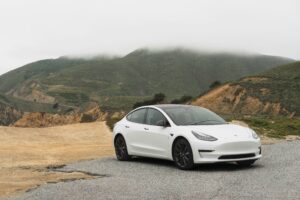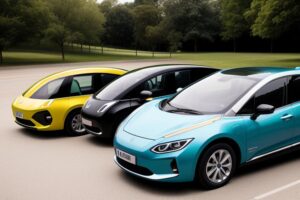In recent years, electric vehicles (EVs) have surged onto the global stage, promising a greener, more sustainable future. With governments around the world setting ambitious targets for reducing carbon emissions, EVs are often hailed as the beacon of modern transportation. Yet, despite their clear environmental benefits and technological advancements, EVs have been met with a surprising amount of skepticism and EV hate. This blog post delves into the paradox of EV resistance, exploring the multifaceted reasons behind the reluctance to embrace what many consider the inevitable shift in automotive technology. From range anxiety to economic concerns, we’ll unpack the layers of criticism and seek to understand the root of the EV backlash. Join us as we navigate through the electric currents of public opinion to uncover why so much animosity is directed toward these vehicles of the future.
Table of Contents: EV Hate?
- The Promise of EVs: Highlighting the advantages of EVs, including environmental impact, technological advancements, and long-term cost savings.
- The Criticism: Addressing common criticisms of EVs such as range anxiety, charging infrastructure concerns, and upfront costs.
- Studies: Understanding Public Perception: Presenting data and studies that reflect public perception and acceptance of EVs, offering evidence-based insights into the factors influencing opinions.
- The Root of the Resistance: Analyzing deeper psychological, economic, and political reasons behind the skepticism towards EVs.
- The Role of Media and Culture: Examining how media portrayal and cultural attitudes contribute to the perception of EVs.
- Moving Forward: Suggesting strategies to overcome resistance and promote the acceptance of EVs.
- Conclusion: Summarizing the discussion and emphasizing the importance of embracing EVs for a sustainable future.
E-HEELP Electric Car Jack Kit 5Ton 12V Hydraulic Car Jack Lift (Lifting Range: 6.1~17.7 inch) with Electric Impact Wrench for SUV MPV Sedan Truck Change Tires Garage Repair

The Promise of EVs
Electric vehicles (EVs) are not just a technological innovation; they are a revolution on wheels. As the world grapples with the urgent need to reduce carbon emissions, EVs offer a beacon of hope. They come with the promise of a cleaner environment, thanks to their zero tailpipe emissions. This is a significant advantage over traditional internal combustion engine vehicles, which contribute to air pollution and global warming.
However, the benefits of EVs extend beyond environmental impact. They represent the cutting edge of automotive technology, with advancements that deliver not only improved efficiency but also enhanced performance. The instant torque and quiet operation of electric motors provide a driving experience that is both exhilarating and serene.
Moreover, the long-term cost savings of EVs can be substantial. With fewer moving parts than conventional cars, EVs typically require less maintenance. The cost of electricity to power an EV can also be lower than the cost of gasoline, especially when taking advantage of off-peak charging rates or home solar power systems.
Despite these promises, EVs have faced criticism and EV hate. In the following sections, we will explore the criticisms in detail and attempt to understand the roots of the resistance to electric vehicles.
The Criticism
Despite the clear advantages of electric vehicles (EVs), they have not been immune to criticism, including a fair amount of EV hate. One of the most vocal concerns is range anxiety—the fear that an EV will not have enough battery life to reach its destination, leaving the driver stranded. This anxiety is compounded by the current state of charging infrastructure, which, although improving, still lags behind the convenience of traditional fuel stations.
Another point of contention is the upfront cost of EVs. While prices are steadily decreasing, electric cars generally remain more expensive than their gasoline counterparts, making them a significant investment for the average consumer. Critics argue that the higher initial cost can be a barrier to widespread adoption, especially in markets where cost sensitivity is a major factor in vehicle purchases.
Additionally, the environmental impact of EVs is sometimes questioned by those who hold onto EV hate. Skeptics point out that the production of EV batteries is energy-intensive and involves materials that may have ethical sourcing concerns. Moreover, the environmental benefits of EVs can be diminished if the electricity used to charge them comes from non-renewable sources.
These criticisms reflect a mix of genuine concerns and misconceptions. They highlight the need for continued innovation in EV technology and infrastructure, as well as transparent communication about the true costs and benefits of electric mobility.
Studies: Understanding Public Perception
To truly grasp the sentiment towards electric vehicles, it’s essential to look at the data and studies that reflect public perception. Recent research has provided valuable insights into how different demographic groups view EVs and the factors that influence their opinions, including both positive enthusiasm and underlying EV hate.
Demographic-Based Public Perception Analysis A study published in the journal Sustainability analyzed public opinion about EVs across various demographic groups on online social networks. The research utilized machine learning techniques to sift through vast amounts of data, revealing that while EVs are gaining popularity, there’s still a significant lack of understanding among the public, alongside pockets of EV hate. This study highlights the importance of targeted communication strategies to address the concerns and misperceptions of different demographic segments.
Exploring Users’ Perceived Benefits and Drawbacks Another study, featured in SpringerLink, delved into users’ perceived benefits and drawbacks of EVs. It found that while traditional cars are still perceived as more comfortable and reliable, there is a growing acceptance of EVs, particularly among women and older individuals who tend to have higher environmental consciousness.
American Perceptions and Resistance A survey conducted in the United States examined American perceptions of EVs and identified sources of hesitation among various subgroups, including sex, education, and prior exposure to EVs. The findings suggest that personal experiences and exposure to EVs can significantly shape one’s willingness to consider them as a viable option.
These studies and surveys shed light on the complex web of factors that influence public perception of EVs. By understanding these factors, policymakers, manufacturers, and advocates can better tailor their approaches to encourage EV adoption.
2 Packs Sunglasses Holders for Car Visor – Magnetic Leather Sunglasses Holder and Ticket Card Clip – Car Visor Accessories (Silver Grey)

The Root of the Resistance:
Understanding the resistance to electric vehicles (EVs) requires a dive into the psychological and societal factors that fuel skepticism, including EV hate. At the core of this resistance is a phenomenon known as status quo bias, a preference for the current state of affairs. Many consumers are comfortable with gasoline-powered vehicles, which have been the standard for over a century. This comfort with the familiar can make the switch to EVs seem daunting.
Misinformation plays a significant role in shaping public opinion. Myths about EV performance, battery life, and even the environmental impact of their production are perpetuated through various media channels, creating a distorted view of EVs’ capabilities and benefits.
Economic factors also contribute to the resistance. The automotive industry has deep ties to fossil fuels, and there are significant economic interests vested in the continuation of gasoline vehicle production. This includes jobs in manufacturing, oil extraction, and the broader network of businesses that support the traditional automotive ecosystem.
Political factors cannot be ignored either. Policymakers may face pressure from lobbyists to maintain the status quo, leading to slower adoption of policies that favor EVs. Additionally, government incentives for EVs can be inconsistent, further complicating the decision for potential EV buyers.
In this section, we’ve explored the underlying reasons behind the resistance to EVs. Overcoming this resistance will require addressing these psychological, economic, and political barriers head-on.
The Role of Media and Culture in Countering EV Hate
The media and cultural attitudes play a pivotal role in shaping public opinion about electric vehicles (EVs). The portrayal of EVs in media can significantly influence consumer perceptions, often determining whether they are viewed as a desirable innovation or an impractical novelty.
Media Influence: Sensational headlines and stories that focus on the limitations or isolated incidents involving EVs can skew public perception, leading to a negative bias. Conversely, positive media coverage can enhance the appeal of EVs, highlighting their benefits and advancements.
Cultural Attitudes: Cultural narratives around car ownership and identity can also impact the acceptance of EVs. In many societies, cars are seen as symbols of status, power, and freedom. Traditional gasoline vehicles, with their roaring engines and established presence, are deeply ingrained in this cultural fabric. EVs, being relatively new and different, can disrupt these traditional notions, leading to resistance.
Advertising and Lobbying: The automotive industry’s advertising campaigns have historically glorified the power and performance of gasoline vehicles. This, coupled with lobbying efforts to maintain the status quo, can create an environment where EVs are perceived as less desirable or inferior.
To overcome the resistance to EVs, it is crucial to address the media narratives and cultural attitudes that contribute to EV skepticism. This involves promoting accurate information, challenging stereotypes, and showcasing the positive aspects of EV ownership.
Drop Stop – The Original Patented Car Seat Gap Filler (As Seen On Shark Tank) – Between Seats Console Organizer, Set of 2 and Slide Free Pad and Light

Moving Forward: Overcoming Challenges and EV Hate
The journey towards widespread acceptance of electric vehicles (EVs) is not without its challenges, including EV hate, but it is a necessary path for a sustainable future. To move forward, we must address the concerns and resistance head-on with a multi-faceted approach:
Education and Awareness: Increasing public knowledge about EVs is crucial. Educational campaigns can dispel myths, provide clear facts about the benefits and limitations of EVs, and showcase real-life success stories of EV adoption.
Improving Infrastructure: Expanding and enhancing the EV charging network is essential to alleviate range anxiety. Investments in fast-charging stations and ensuring their availability in diverse locations will make EVs more practical for everyday use.
Economic Incentives: Governments can play a pivotal role by offering subsidies, tax breaks, and other incentives to make EVs more financially accessible. Additionally, supporting the development of affordable EV models can help bridge the gap in upfront costs.
Technological Advancements: Continuous innovation in battery technology and energy efficiency can address many of the current criticisms of EVs. Striving for longer battery life, shorter charging times, and more sustainable production practices will improve the EV proposition.
Cultural Shift: Changing the narrative around EVs to one that celebrates their potential can influence cultural attitudes. Highlighting the role of EVs in combating climate change and their place in the future of transportation can shift public perception.
By embracing these strategies, we can overcome the barriers to EV adoption and pave the way for a cleaner, more efficient, and sustainable mode of transportation. The road ahead is electric, and with collective effort, we can ensure that EVs are not just accepted but embraced as a vital part of our mobility ecosystem.
Conclusion of EV Hate?
As we reach the end of our exploration into the resistance against electric vehicles (EVs), it’s clear that the journey towards electrification is complex and fraught with challenges. Yet, it is a path that holds immense promise for our planet and future generations. The skepticism and criticism that EVs face are not insurmountable; they are simply the growing pains of a transformative shift in our approach to transportation.
Understanding the roots of EV resistance—from psychological biases to economic and political interests—allows us to address these issues with clarity and purpose. By fostering education, improving infrastructure, offering economic incentives, advancing technology, and shifting cultural narratives, we can smooth the road ahead for EVs.
The potential of electric mobility is undeniable. It’s time to embrace this potential and work collectively to dispel the myths and embrace the benefits. Let’s not allow the noise of resistance to drown out the opportunity for progress. Instead, let’s accelerate towards a cleaner, more sustainable future, powered by electric innovation.
You may also like:




